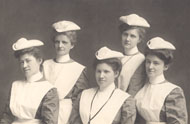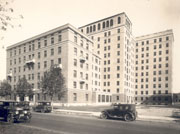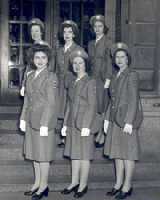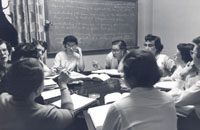Health Professions
The History of the Washington University School of Nursing
The Washington University School of Nursing, originally called the Training School for Nurses, was organized in 1905. The three-year, non-collegiate program led to a diploma in nursing. The first class, numbering five, was graduated in 1908. At that time, theoretical and practical instruction was given to the student nurses by the clinical and laboratory teachers of the Medical School, as well as by the staff of the Training School. The early course of instruction covered anatomy, physiology, pathology, bacteriology, chemistry, dietetics, obstetrics, medical and surgical nursing, pediatrics, general nursing, ethics, and materia medica. Students were furnished with uniforms and books, and were paid a small monthly sum.
In 1924 the School was reorganized and became the School of Nursing. At that time a five-year program leading to a bachelor’s of science degree in Nursing was added, combining a two-year program of college courses with three years of nurses’ training. Education and training would prepare students not only for bedside nursing but also for service in the varied fields of Public Health Nursing and for supervision and teaching in hospitals and schools of nursing.
In the first years of the Training School for Nurses, the requirements for admission included an interview with the Superintendent to determine if the student had enough mature intelligence to carry out and obey orders. Candidates had to be between 20 and 35 years of age and “of good physique.” References from a “responsible person,” usually a minister, testifying to their good moral character and a physician’s certificate of “sound health and unimpaired faculties” were also required. A high school diploma was preferred, but not required, until 1915. The following year admission standards were changed to parallel those of other schools of the University.
In September 1929 a program in Public Health Nursing for registered nurses was introduced, made possible by a financial gift from Mr. and Mrs. George Oliver Carpenter and the Rockefeller Foundation. The program was discontinued in June 1936.
The Depression caused a drop in the patient census of hospitals, and thus the number of both student and graduate nurses needed. In the early 1930s, many nursing schools, including Washington University, limited the number of applicants admitted and took steps to have the smaller training schools for nurses closed or consolidated, thereby increasing the necessity of employing graduate nurses. By the late 1930s, however, as the economy started to recover, there was a recognized scarcity of nurses and a renewed effort to enroll student nurses.
In 1941 the National League of Nursing Education listed the Washington University School of Nursing among its initial list of schools meeting its accreditation standards. During the Second World War, the shortage of nurses prompted the School to lower the age of admission to 17, and to admit three classes of students per year. During the 1930s an average of 38 nurses were graduated each year. In the 1940s the average rose to 62.
In an effort to address the nursing shortage, the U.S. Public Health Service established the Cadet Nurse Corps in 1943. Students joining the Corps promised to continue in essential nursing service for the duration of the war. They could choose the kind of nursing: Army or Navy Corps, Government or civilian hospitals, or public health nursing. In return, the Government paid the students’ tuition and fees and an additional monthly stipend. The Washington University School of Nursing was the first school in St. Louis to participate in the program.
In 1951 a Master of Science Degree in Nursing was introduced. Candidates for the degree could specialize in the fields of teaching in clinical nursing, supervision in hospital nursing services, maternal and child nursing, psychiatric nursing, and medical-surgical nursing. In 1954 the School of Nursing was reorganized and placed directly under Washington University, thus becoming an autonomous school of the University. Prior to 1954, the School of Nursing had been under the supervision of the University’s School of Medicine.
The Central Administration Committee of Washington University agreed to admit male students into the School of Nursing in November 1950. The first African-American to receive a degree from the Washington University School of Nursing was Mrs. Wanda Hall, who received a master’s degree in 1953 after completing the Advanced Program in Psychiatric Nursing. Mrs. Hall then joined the faculty as an instructor in Psychiatric Nursing.
Similar to other university programs in the 1950s, Washington University discontinued its three-year diploma and five-year degree programs. Hospital schools of nursing were taking over the responsibility of training nurses in programs leading to a degree in nursing. (As an example, Barnes Hospital admitted its first class in its Diploma School of Nursing in September 1955.) Universities assumed responsibility for developing programs on the collegiate level. In 1957 the final classes of diploma and degree students of the Washington University School of Nursing graduated under the old plan. In 1958 the University developed plans establishing a four-year basic Baccalaureate Program. Funding was secured and the first class was admitted in September 1961.
All nursing programs were terminated in July 1969. Over its 64-year history, the Washington University School of Nursing graduated over 2,000 nurses.
With the closing of the Washington University School of Nursing, the only remaining baccalaureate program in nursing in St. Louis at that time was the St. Louis University School of Nursing, which had been established in 1928. For a history of the St. Louis University School of Nursing, visit Heritage of Saint Louis University School of Nursing.
Related Links:
Return to Nursing (Health Professions)
Return to Health Professions
Back to Top





